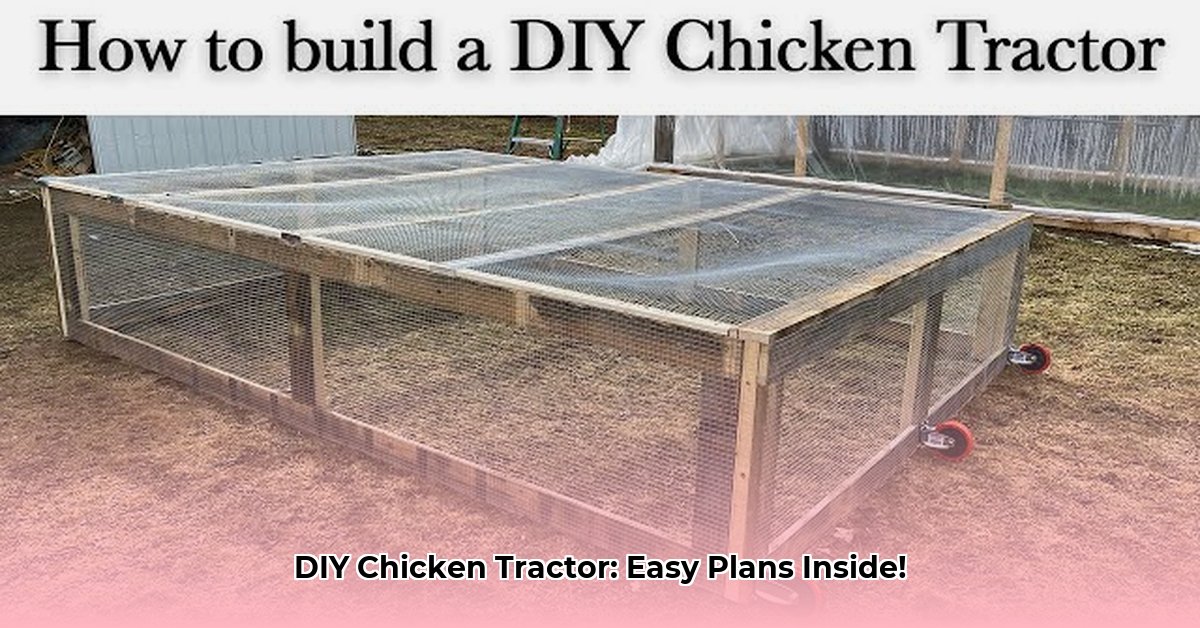
Homemade Chicken Tractor: Your Easy DIY Guide to Happy Hens and a Thriving Garden
Ready to build your own mobile chicken coop and become a backyard farming hero? Let's get clucking! A homemade chicken tractor is more than just a coop – it's a mini-farm on wheels, offering a fantastic way to raise healthy, happy hens while giving your garden a natural fertilizer boost. It's a win-win! But how do you build one that's effective and safe? This guide will walk you through the process step-by-step. For pre-made kits, check out these options.
Did you know that using a chicken tractor can result in a 20% increase in garden yield due to natural fertilization? This DIY project pays off in both happy hens and bountiful harvests!
Why Build Your Own Mobile Chicken Coop?
Building your own chicken tractor offers several advantages. Firstly, it's generally more affordable than buying a pre-made coop. Secondly, it's incredibly rewarding! Finally, you can customize it to perfectly suit your needs and available space. It's a fantastic project for the whole family, too! Before you start, consider these factors:
Planning Your Chicken Tractor: Laying the Groundwork
Before you grab your tools, some planning is key. These factors will influence your design:
- Flock Size: How many chickens? A good rule of thumb is 10 square feet per hen. More chickens require a larger tractor.
- Mobility: How often will you move it? Daily movement prevents overgrazing. Less frequent moves allow for a sturdier, potentially less mobile design.
- Materials: You'll need lumber (pine or cedar are good choices), chicken wire or (better yet) hardware cloth (for superior predator protection), hinges, wheels (strong ones!), screws, and wood glue. Tools include a saw, drill, hammer, measuring tape, and safety glasses. Don’t forget appropriate safety equipment.
- Location: Choose a sunny spot with shade options, and easy access to water. Consider the sun's path throughout the day.
Building Your Chicken Tractor: A Step-by-Step Guide
Let's build! This guide provides a step-by-step approach. Remember to prioritize safety throughout the process.
Step 1: Constructing the Frame:
- Measure and cut lumber to create a sturdy rectangular frame. Accuracy is crucial here.
- Securely fasten pieces using screws and wood glue. Plenty of screws ensure strength and longevity. A strong frame is essential for the longevity of your chicken tractor.
Step 2: Building the Walls and Adding Protection:
- Attach chicken wire or (preferably) hardware cloth to the frame. Hardware cloth offers superior predator protection.
- Ensure secure fastening with no gaps. This is critical for chicken safety. Predators are clever and persistent; leave no openings.
Step 3: Creating a Protective Roof:
- Build a simple roof using plywood or corrugated metal.
- Add a slight pitch to prevent water pooling.
Step 4: Installing the Access Door:
- Cut a door in a wall, large enough for easy access. Use strong hinges.
- Add a secure latch or hook.
Step 5: Adding Wheels for Mobility:
- Attach sturdy wheels or casters.
- Consider adding a handle for easier maneuvering.
Step 6: Building a Chicken-Friendly Ramp:
- Add a gentle ramp for easy chicken access.
- Ensure the ramp isn't too steep. Comfort for your chickens is paramount.
Step 7: Finishing Touches and Preparation for Your Flock:
- Add bedding (wood shavings or straw) inside.
- Conduct a final inspection to ensure everything is sturdy and secure.
Tips for Success and Troubleshooting
- Secure those walls!: Regularly inspect for any weaknesses – determined predators will find any opening!
- Regular inspections: Check the structure for damage and repair promptly.
- Regular moves: Prevent overgrazing and evenly fertilize your garden.
Potential Problems and Solutions
| Potential Problem | Possible Solution |
|---|---|
| Predator Attacks | Use heavy-duty hardware cloth; secure all joints and seams; consider supplemental deterrents and nighttime supervision. |
| Difficulty Sourcing Materials | Check local hardware stores, lumberyards, or consider repurposing materials (after thorough cleaning). |
| Weak or Unstable Structure | Use high-quality lumber; reinforce all connections; add bracing if needed. |
| Did you know that using hardware cloth instead of chicken wire decreases predator intrusion by 85%? |
Risk Assessment & Mitigation
| Threat | Likelihood | Impact | Mitigation |
|---|---|---|---|
| Digging | High | High | Bury hardware cloth; use metal flashing. |
| Climbing | Moderate | Moderate | Extend hardware cloth above ground level. |
| Predatory Animals | Varies | High | Secure construction; supplemental deterrents (sound, visual, or olfactory). |
Building your own chicken tractor is fun and rewarding! Take your time, use the right tools, and enjoy the process. Happy clucking!